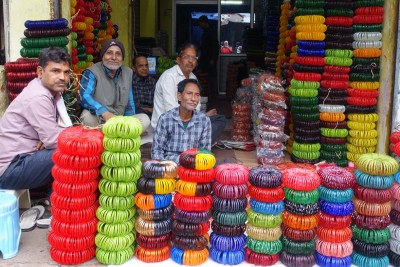Uttar Pradesh with a Difference
(vero;2024-Feb-29)
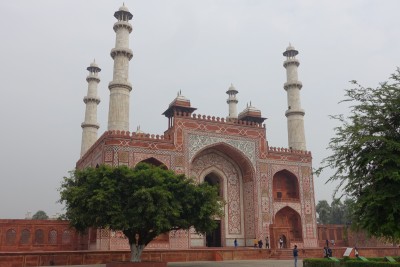 Uttar Pradesh is a state of superlatives:
Uttar Pradesh is a state of superlatives:
- It is the most populated state in India (over 241 million inhabitants) accounting for 16.5 % of the total Indian population.
- It is India's fourth-largest state in terms of land area, roughly the same size as the United Kingdom, covered by vast and fertile plains watered by the highly revered and spiritual rivers of the Ganges and Yamuna.
- It is an important religious destination for pilgrims from all faiths, being Buddhist, Hindu, Jain or Muslim.
- Its monuments and cities bear witness to its rich history from the Delhi Sultanate, the Mughal Empire, the British Raj to the 21st century.
We had already been three times in this state and had explored most of its highlights: Agra with the Taj Mahal and its incredible Muslim heritage left by the Mughals, Varanasi and Prayagraj (former Allahabad) for Hindu spirituality, Sarnath and Kushinagar for the roots of Buddhism, Lucknow for some Raj history and more Muslim heritage. So why go there again? Well as a start, for the simple reason that Agra and Varanasi were convenient stops on our way to Bihar, but also because these two cities are unique and always worth a trip; we were also curious to see whether things had changed since our previous visits in 2004, 2009 and 2013. We had much time on our hands, so we started with two days in Mathura, a city which we did not know, just one hour and forty minutes away from Delhi by train and made some enjoyable day trips to Firozabad from Agra and Jaunpur from Varanasi.
Mathura and Vrindavan
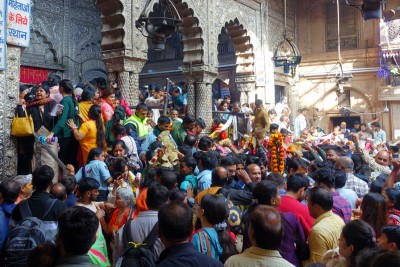 Mathura, on the banks of the river Yamuna, is the birth place of Krishna and as such sees a lot of pilgrims. The main temple is the Krishna Janambhoomi temple, its main attraction being a cave where Krishna is said to have been born. There are many devotees visiting and the crowds are filtered and scanned at the entrance; photo is forbidden and bags must be left at a cloackroom for 10 Rs. Most striking actually is the building next to the temple: Kastra Masjid, a mosque built by Aurangzeb in 1661 on the grounds of a temple he had ordered to be destroyed. This mosque is now out of bounds and completely blocked off for fear of religious feuds such as what happened in Ayodhya in 1992 when a Hindu mob destroyed the Babri Masjid Mosque built over a temple believed to be Rama's birth place, prompting a series of murderous inter-communal riots which shook the whole of India. Other than that, there was not a lot of religious activity going on in town when we visited (end of November). The ghats were empty (they might have been busier in the early hours) and we had expected to see more devotees around when the Dwarkadhesh Temple re-opened at 16:30 for puja. We found the town quite dirty with many roaming cows, famished dogs and far too many annoying monkeys. The town centre and the river front are lined in places by havelis, neglected or in a semi-state of ruin. The main street is however quite busy and there are many workshops where people make feet and ankle bracelets. Our guide book praised the government museum but we did not have time and decided against it: this might have been an error…
Mathura, on the banks of the river Yamuna, is the birth place of Krishna and as such sees a lot of pilgrims. The main temple is the Krishna Janambhoomi temple, its main attraction being a cave where Krishna is said to have been born. There are many devotees visiting and the crowds are filtered and scanned at the entrance; photo is forbidden and bags must be left at a cloackroom for 10 Rs. Most striking actually is the building next to the temple: Kastra Masjid, a mosque built by Aurangzeb in 1661 on the grounds of a temple he had ordered to be destroyed. This mosque is now out of bounds and completely blocked off for fear of religious feuds such as what happened in Ayodhya in 1992 when a Hindu mob destroyed the Babri Masjid Mosque built over a temple believed to be Rama's birth place, prompting a series of murderous inter-communal riots which shook the whole of India. Other than that, there was not a lot of religious activity going on in town when we visited (end of November). The ghats were empty (they might have been busier in the early hours) and we had expected to see more devotees around when the Dwarkadhesh Temple re-opened at 16:30 for puja. We found the town quite dirty with many roaming cows, famished dogs and far too many annoying monkeys. The town centre and the river front are lined in places by havelis, neglected or in a semi-state of ruin. The main street is however quite busy and there are many workshops where people make feet and ankle bracelets. Our guide book praised the government museum but we did not have time and decided against it: this might have been an error…
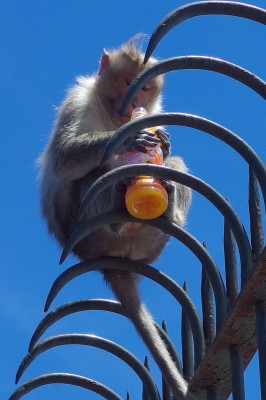 Next day we took a bus to Vrindavan, the place where Krishna spent his youth and where many of the stories linked to him took place, among others the one with the Gopis (milk maids). The town is pleasant with a rural feel and more interesting than Mathura. There are many temples around and visiting them requires a bit of organisation as most of them are closed between 12:00 and +/- 16:00. From all temples we visited, we will definitely remember the Govind Dev and the Banke Behari temples. Govind Dev for its architecture in red sandstone and Banke Behari for the "religious experience".
Next day we took a bus to Vrindavan, the place where Krishna spent his youth and where many of the stories linked to him took place, among others the one with the Gopis (milk maids). The town is pleasant with a rural feel and more interesting than Mathura. There are many temples around and visiting them requires a bit of organisation as most of them are closed between 12:00 and +/- 16:00. From all temples we visited, we will definitely remember the Govind Dev and the Banke Behari temples. Govind Dev for its architecture in red sandstone and Banke Behari for the "religious experience".
We had decided to join the pilgrims queuing outside Banke Behari to go and have a look at the inner sanctum. Well, it was sheer madness: imagine a huge grape of people funnelled into a dark, narrow, tortuous and seemingly endless corridor and the two of us in the midst of it all. It was quite scary as we were carried by the flow of pressing people, we could not see where we put our bare feet, the floor was uneven and the only thing we could think of was not to stumble and hope that there wouldn't be any sudden movement of panic. The situation got better when we finally emerged, or more accurately, were expelled into the main hall.
The idol itself is kept behind a curtain, quite far away from the barrier which keeps the jammed crowds at bay. As far as we were concerned, we had enough of crowd crushing and were not interested in seeing the idol so we crossed the hall (with difficulty) and found a relatively quiet place near the exit where we could observe the devotees pressed in front of the inner sanctum and how they would cry in ecstasy when the curtain was lifted at regular intervals (it is believed that looking at the idol for too long will make one lose consciousness). Crazy.
But more excitement was to come… We were relieved to be back in the open air and were regaining our senses in a side street, both looking into our guide book to decide where to go next when it suddenly happened! Out of nowhere, a monkey jumped from a roof onto Thomas' shoulder, bounced back to the roof, snatching the reading glasses which were on Vero's nose on the way. Wow. People had warned us to hold everything tight: food of course but also purses, phones, even glasses. We had registered the warning but did not think that a monkey would go to the length of grabbing Vero's glasses directly from her face. It was so quick, we hardly saw it happen. And here was our friend, back on his roof, nibbling nonchalantly the temples of the glasses. Fortunately, Thomas had advised Vero against taking her brand new bifocals to India (and had been heard!), so it was not a big loss, a 1£ pair of reading glasses and we had packed some spare ones… So we set off to leave the place when people around told us to wait. We waited for a while but nothing happened, the monkey was still up there nibbling the glasses happily. That is until somebody from the crowd of onlookers threw a box of sweets to the animal (we should have thought of it ourselves): the monkey immediately dropped the glasses to catch the box. That was it!
After all these emotions, we headed to the Yamuna for fresh air and wandered along the ghats to enjoy the river views, stopping along the way to check a few more temples. Whereas we did not see any foreign tourist in Mathura, there were a few in Vrindavan as many go there to attend courses and seminars at the ISKCON centre, aka Hare Krishnas. Their temple is said to be impressive and beautiful but we did not visit.
Make sure to check our photo gallery dedicated to Mathura and Vrindavan.
No need to present Agra. The town is very touristy but still very enjoyable with its wide avenues and unique monuments. We decided against the Taj Mahal which we had already seen twice and which price we found quite extortionate. We visited however Agra Fort and went to Sikandra to see Akbar's Mausoleum. A good tip for Agra Fort is to visit in the morning: tourists visiting the Taj get a (minimal) discount of 50 Rs for the Fort if they visit it on the same day. This means that the crowds start to arrive around midday (as we could observe). Check this web page for the current entry fees of Agra's monuments.
We enjoyed Agra Fort but (as in many other sites during this trip) found that some areas were cordoned off to manage the flux of visitors and protect some of the courtyards / pavilions. Sikandra was new to us and by far not so crowded, which made it a very enjoyable outing.
We had planned to stay five days in Agra and had much time on our hands. So we looked at towns in a radius of 40 km and after a bit of research decided that we would pay a visit to Firozabad, the bangle city of India. We had no idea what to expect, not a clue as to where the market or the town centre were but it did not prove difficult at the end: we just followed the carts full of bangles which were pushed through the streets and found the bangle sellers. The bangles looked to us at first sight as if they were made of plastic but people insisted they were made of glass and indeed: doubting Thomas made the flame test and they did not melt! We paid a short visit to the mosque and to a Jain temple, but that was it for sight-seeing. What made the day were the people. They were utterly friendly and very curious about us; it is not often that Westerners come their way. The city is busy with trade and shops, there are many glass workshops selling beautiful items made of glass. The bus took one and half hour to get there (and the same back) and we spent three hours in town. It was definitely worth it, we will keep very fond memories of Firozabad.
Varanasi, Sarnath and Jaunpur
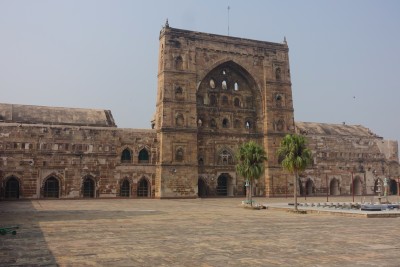 It was our fourth visit to Varanasi and we found the city as mesmerising as ever. We spent a lot of time wandering along the ghats and noticed quite a few changes; they are much cleaner for a start, less cows as before, waste bins at regular intervals, toilet facilities and the Ganges water cleaner (not so much waste flowing down the river). We were not bothered by any touts and there were not many foreigners around. We were stunned at the changes made behind the Lalita and Manikarnika Ghats. The area has been massively revamped: old houses and streets have been flattened to make place for the Kashi Vishwanath Dham Project (inaugurated in December 2021) resulting in a huge area linking the holy Shri Kashi Vishwanath temple to the ghats and the Ganges. Just to give an idea of the magnitude of this project: the temple area which used to occupy an area of roughly 1000 m2 has now been increased to 152,000 m2 with open esplanades, wide avenues, visitor centre, shops, cloakrooms, food court, all designed to accommodate and channel the ever growing crowds of pilgrims. Click here to check our 2013 photo gallery dedicated to Varanasi.
It was our fourth visit to Varanasi and we found the city as mesmerising as ever. We spent a lot of time wandering along the ghats and noticed quite a few changes; they are much cleaner for a start, less cows as before, waste bins at regular intervals, toilet facilities and the Ganges water cleaner (not so much waste flowing down the river). We were not bothered by any touts and there were not many foreigners around. We were stunned at the changes made behind the Lalita and Manikarnika Ghats. The area has been massively revamped: old houses and streets have been flattened to make place for the Kashi Vishwanath Dham Project (inaugurated in December 2021) resulting in a huge area linking the holy Shri Kashi Vishwanath temple to the ghats and the Ganges. Just to give an idea of the magnitude of this project: the temple area which used to occupy an area of roughly 1000 m2 has now been increased to 152,000 m2 with open esplanades, wide avenues, visitor centre, shops, cloakrooms, food court, all designed to accommodate and channel the ever growing crowds of pilgrims. Click here to check our 2013 photo gallery dedicated to Varanasi.
We stayed five days in Varanasi and made two day-trips from there. The first one to Sarnath, the place where the Buddha held his first sermon. We had already been there twice and remembered a rural and a rather sleepy town; I quote from our 2013 blog article: <<Sarnath is an easy day-trip from Varanasi. It is even more sleepy than Kushinagar and there is not a great deal to see on the ground: a few ruins, a few nondescript monasteries but still, it was nice to be there.>> Well, this visit was a shock and a huge disappointment, one of those things which one regrets doing: keep your memories, don't revisit. The place is now plagued by mass tourism. There are scores of buses disgorging eager visitors, most of them shouting, making selfies and having a good time; souvenir sellers sell all kind of crap and religious paraphernalia and the place is full of wedding halls, colourful and garish affairs geared to hosting huge wedding parties. The ruins and the temples have become a secondary backdrop, there is surely no spirituality to be found in Sarnath anymore, unless, we hope, you are staying at a monastery and take Buddhism seriously; the Myanmar and Cambodia monasteries, away from the main drag, were empty and peaceful when we visited and gave us hope that this is the case (what cannot be said of the Thai temple).
Our second destination was the town of Jaunpur, some 60 km north west of Varanasi. We went there to see its praised Islamic architecture and we were not disappointed. The town has very beautiful and impressive mosques dating from the 14th and 15th centuries, their central arches on their front facades are said to be the highest in India (over 22 m high). Jaunpur is located on the banks of the Gomti river and an impressive arched bridge built in the 16th century is the gateway to the town. This bridge is called Akbari Bridge in honour of the man who ordered its construction, no less than the Emperor Akbar himself. There is also a fort, which we did not visit (see our rant about ASI). Seeing these monuments was really worth the trip, the first sight of the Jami Masjid was breath taking. unfortunately, other than that, we found Jaunpur without charm and dirty, the ghats and the river "promenade" neglected.
Want to read more? Go back to Trip Report and Budget or go on to Uttar Pradesh with a Difference or go up to Blog
$updated from: Blog.htxt Tue 05 Mar 2024 14:11:10 trvl2 (By Vero and Thomas Lauer)$




